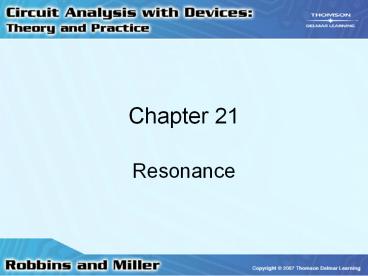Resonance - PowerPoint PPT Presentation
Title:
Resonance
Description:
Chapter 21 Resonance Series Resonance Simple series resonant circuit Has an ac source, an inductor, a capacitor, and possibly a resistor ZT = R + jXL jXC = R + j ... – PowerPoint PPT presentation
Number of Views:166
Avg rating:3.0/5.0
Title: Resonance
1
Chapter 21
- Resonance
2
Series Resonance
- Simple series resonant circuit
- Has an ac source, an inductor, a capacitor, and
possibly a resistor - ZT R jXL jXC R j(XL XC)
- Resonance occurs when XL XC
- At resonance, ZT R
3
Series Resonance
- Response curves for a series resonant circuit
4
Series Resonance
5
Series Resonance
- Since XL ?L 2?fL and XC 1/?C 1/2?fC for
resonance set XL XC - Solve for the series resonant frequency fs
6
Series Resonance
- At resonance
- Impedance of a series resonant circuit is small
and the current is large - I E/ZT E/R
7
Series Resonance
- At resonance
- VR IR
- VL IXL
- VC IXC
8
Series Resonance
- At resonance, average power is P I2R
- Reactive powers dissipated by inductor and
capacitor are I2X - Reactive powers are equal and opposite at
resonance
9
The Quality Factor,Q
- Q reactive power/average power
- Q may be expressed in terms of inductor or
capacitor - For an inductor, Qcoil XL/Rcoil
10
The Quality Factor,Q
- Q is often greater than 1
- Voltages across inductors and capacitors can be
larger than source voltage
11
The Quality Factor,Q
- This is true even though the sum of the two
voltages algebraically is zero
12
Impedance of a Series Resonant Circuit
- Impedance of a series resonant circuit varies
with frequency
13
Bandwidth
- Bandwidth of a circuit
- Difference between frequencies at which circuit
delivers half of the maximum power - Frequencies, f1 and f2
- Half-power frequencies or the cutoff frequencies
14
Bandwidth
- A circuit with a narrow bandwidth
- High selectivity
- If the bandwidth is wide
- Low selectivity
15
Bandwidth
- Cutoff frequencies
- Found by evaluating frequencies at which the
power dissipated by the circuit is half of the
maximum power
16
Bandwidth
17
Bandwidth
- From BW f2 - f1
- BW R/L
- When expression is multiplied by ? on top and
bottom - BW ?s/Q (rad/sec) or BW fs/Q (Hz)
18
Series-to-Parallel Conversion
- For analysis of parallel resonant circuits
- Necessary to convert a series inductor and its
resistance to a parallel equivalent circuit
19
Series-to-Parallel Conversion
- If Q of a circuit is greater than or equal to 10
- Approximations may be made
- Resistance of parallel network is approximately
Q2 larger than resistance of series network - RP ? Q2RS
- XLP ? XLS
20
Parallel Resonance
- Parallel resonant circuit
- Has XC and equivalents of inductive reactance and
its series resistor, XLP and RS - At resonance
- XC XLP
21
Parallel Resonance
- Two reactances cancel each other at resonance
- Cause an open circuit for that portion
- ZT RP at resonance
22
Parallel Resonance
- Response curves for a parallel resonant circuit
23
Parallel Resonance
- From XC XLP
- Resonant frequency is found to be
24
Parallel Resonance
- If (L/C) gtgt R
- Term under the radical is approximately equal to
1 - If (L/C) ? 100R
- Resonant frequency becomes
25
Parallel Resonance
- Because reactances cancel
- Voltage is V IR
- Impedance is maximum at resonance
- Q R/XC
- If resistance of coil is the only resistance
present - Circuit Q will be that of the inductor
26
Parallel Resonance
- Circuit currents are
27
Parallel Resonance
- Magnitudes of currents through the inductor and
capacitor - May be much larger than the current source
28
Bandwidth
- Cutoff frequencies are
29
Bandwidth
- BW ??2 - ?1 1/RC
- If Q ? 10
- Selectivity curve becomes symmetrical around ?P
30
Bandwidth
- Equation of bandwidth becomes
- Same for both series and parallel circuits































